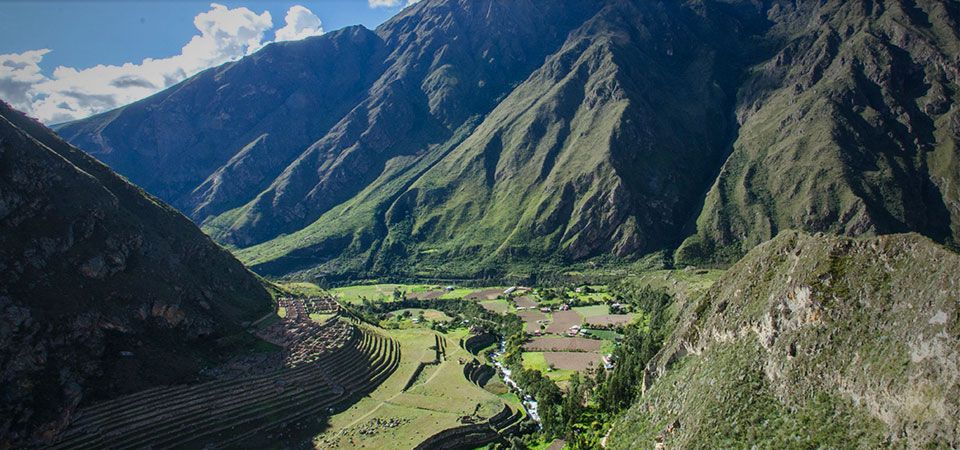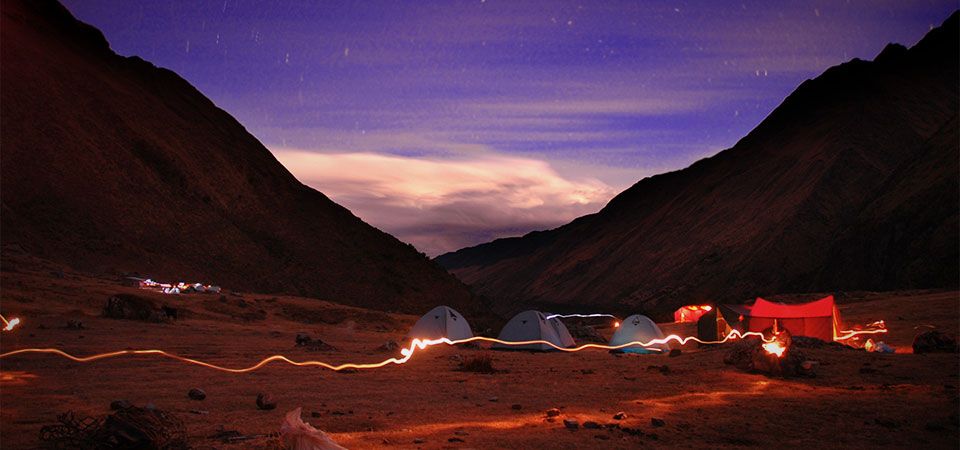

What is now called the Inca Trail is actually a small section of a greater network of trails that once connected the great Inca Empire. Known as the Qhapaq Nan, these trails spanned out from the Incan capital of Cusco to the far corners of their vast empire into present-day Ecuador, Bolivia, Chile and Argentina. This complex trail system enabled swift and reliable travel, communication and easy transportation of food, and was also used by Inca soldiers. In fact, the road system in its entirety has been granted World Heritage status by UNESCO.
A modern-day journey on the Inca Trail takes you along the most special section of the network, believed to have once reserved for highest-ranking members of the Inca aristocracy, through the Sun Gate and into Machu Picchu.
The land that the Inca Trail traverses has a rainy season and dry season with gradual weather and temperature changes in between. The mountainous geography of the Andes has a wide variety of microclimates that range between warm and humid valleys to frosty high altitude plains. Generally, as elevations climb higher, temperatures drop.
Dry Season
June, July, and August mark the heart of the dry season in the Andean region of Peru. During these months, sunshine is regular with a minimal chance of rainfall. Daytime temperatures usually range from 68 to 73°F (20 to 23°C), but night temperatures drop to a chilly 30 to 45°F (-1 to 7°C) at high altitude campsites.

Geography
The Inca Trail hike crosses four ecozones with distinct microclimates.
Wet Season
November to March is the wet season in Peu’s Andean region. Daytime temperatures average between 68 to 70°F (20 to 21°C). Nights are warmer compared to the dry season with an average temperature of about 45°F (7°C).
The Inca Trail hike crosses four ecozones with distinct microclimates.

For more detailed information about the route the Inca Trail takes to Machu Picchu, check out our blog Step by Step to Machu Picchu: Inca Trail Map
The best time to hike the Inca Trail is during the dry season, from May-October. This provides mostly dry and sunny weather, with nice crisp air in the mountains. Keep in mind, though, that this would be the busiest time to do the trail.
If you don’t mind some more mixed weather, the shoulder months of April and November offer fewer crowds with still some beautiful days with perhaps a few more rain showers here and there (which can prove quite refreshing while hiking). In April, be sure to avoid traveling in Peru during Semana Santa (Holy Week, leading up to Easter), as this is a very busy travel time for locals and services can be limited and more pricey.
Note that the Inca Trail is completely closed the entire month of February.
Day 1: Cusco – Ollantaytambo – Wayllabamba

Hike Distance: 12 km (7.5 mi)
Hike Time: 4 to 6 hrs
Maximum Altitude: 3,000 m (9,842 ft)
Gradient: Moderate
Day 2: Inca Trail – Wayllabamba to Pacaymayo

Hike Distance: 16 km (10 mi)
Hike Time: 7 to 8 hrs
Maximum Altitude: 4,215 m (13,828 ft)
Gradient: Challenging
Day 3: Inca Trail – Pacaymayo to Wiñayhuayna

Hike Distance: 16 km (10 mi)
Hike Time: 8 to 10 hrs
Maximum Altitude: 3,900 m (12,467 ft)
Gradient: Moderate
Day 4: Wiñayhuayna – Machu Picchu

Hike Distance to Machu Picchu: 6 km (3.7 mi)
Hike Time: 3 to 5 hrs
Maximum Altitude: 2,650 m (8,694 ft)
Gradient: Moderate
Note: There is also a shorter 2-day Inca Trail option. The 2-day Inca Trail is ideal for travelers who have limited time or may desire a less physically demanding option than the classic 4-day Inca Trail itinerary. It is also a great option if 4-Day Permits have sold out.
Our 2-day Inca Trail hiking package includes a day of hiking surrounded by the beauty of the Andes, walk past Chachabamba, an archaeological complex believed to have served as a guardhouse to Machu Picchu, and past Wiñay Wayna. Enter the Sun Gate for a first encounter with the “Lost City of the Incas.” Spend the night at a comfortable hotel in Aguas Calientes and then wake up the next day for a guided tour of Machu Picchu.
Inca Trail Permits Are Limited

Each day only 500 permits for the Inca Trail are issued by the Peruvian government. This total includes all the trekkers on the 2-day and 4-day routes as well as the guides, porters and cooks that accompany organized trekking groups. Available permits for the Inca Trail sell out quickly due to high demand, sometimes 5 months in advance for dates during the dry season from May to September, so booking far in advance is a must.
The Trail Closes Every February
The Peruvian government closes the trail in February for annual maintenance, conservation and clean-up. It’s open every other month of the year.
Required Items
Aside from packing list items you will need, here are important items that you must have:
Prohibited Items
Prohibited items include:
Prohibited Activities
Respect this historic trail by adhering to the following:{" "}
Advanced Booking Is a Must
It’s very important to buy your tickets for the Inca Trail trek in advance. Early planning does always not guarantee a spot, but greatly increases your chance of securing the trekking dates you want. During high season, from April through October, permits can sell out 6 months beforehand.
Before the Trek, Adjust to the Altitude
We recommend spending a few days in Cusco before your trek begins to give your body plenty of time to adjust to the high altitude region. Cusco is a city that resides at 11,120 ft (2,400 m) above sea level. The highest mountain pass along the Inca Trail is at a soaring 13,830 ft (4,214 m).
Packing List
Documentation.
Bring your original passport. You will need it both to start the
Inca Trail and to enter Machu Picchu through the Sun Gate.
Day Pack
Bring a comfortable daypack with snug straps to wear while you hike.
Unless you hire a private
Inca Trail porter
, you’re expected to carry both pads and sleeping bags along the
trek.
Reusable water bottle.
Carry a reusable water bottle in your daypack. Another option is a
hydration pack, like a CamelBak, which is a super convenient way to
stay hydrated.
Clothing.
Layers, layers, layers. You’ll pass through many different climates
along the trail and dressing in layers is important. Pack
lightweight pants, short- and long-sleeve shirts, a warm fleece
jacket, underwear, and socks. Temperatures really drop at altitude
when the sun goes down. To stay warm, thermal undergarments, a warm
hat, and gloves are recommended.
Footwear.
Comfortable hiking boots or walking shoes are a must. Also pack
shower sandals.
Rain gear.
Be prepared with a rain jacket and pants or poncho. Rainy conditions
aren’t to be expected during the dry season, but it’s better to be
prepared.
Sun protection.
Pack a hat, strong sunblock, and glasses for protection against the
sun.
Flashlight.
Headlamp (with extra batteries) or small flashlight to use at night
while camping.
Comfort.
Light-weight travel towel to shower with and a small travel pillow
for your sleeping comfort. Some trekkers may prefer to bring walking
sticks, they are especially helpful in downhill sections.
Toiletries.
Toothbrush, toothpaste, travel shampoo, tissues, toilet paper, wet
wipes, insect repellent with deet, and any personal medications.
Snacks.
You may want to bring extra (or diet specific) high energy snacks,
such as some cookies, protein bars, chocolates, or nuts.
Money.
Bring local Peruvian currency (Soles) in your wallet so that you can
tip your trekking team.
Camera.
Of course, don’t forget your camera, with extra battery packs and
memory cards.
Tipping
On the last night of your trek, there is a tipping custom: all the hikers put their tips together and give them to the guide. The guide will then distribute that money between all the Inca Trail personnel. We advise anything from $40 to $60 USD per hiker.
What to Do If Inca Trail Permits Are Sold Out
If permits for the Inca Trail are already sold out for the dates you want, fortunately, there are great alternative treks to Machu Picchu you can also do. The Salkantay, Lares, and Choquequirao are great alternative treks – and just like the iconic 4-day Inca Trail – they are all ancient Inca footpaths that belong to a vast network of roads that once connected the entirety of the Inca Empire whose capital was in Cusco. Talk with your travel advisor about which trek option is best for you.


Climb out of the Sacred Valley towards Warmiwanusca, or Dead Woman’s Pass, on the second day of the classic Inca Trail 4-day. This highest point of the trek at 4,215 m (3,828 ft) with stunning views at the summit.
Torre Mirador is 12.5 mi (20 km) to the north of Nazca city along the Panamerican Highway.






6 days from $1919
Cusco, Rainbow Mountain, Machu Picchu & 2-day Inca Trail


9 days from $2239
Cusco, Inca Trail, Sacred Valley & Machu Picchu
Email: [email protected]
Sign up to receive our newsletter for great articles, stunning photos, and special deals.